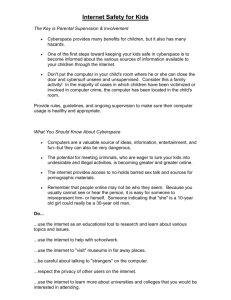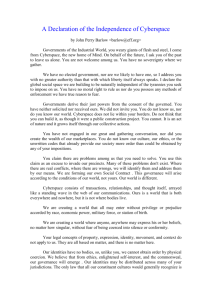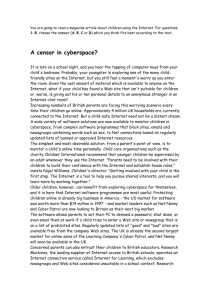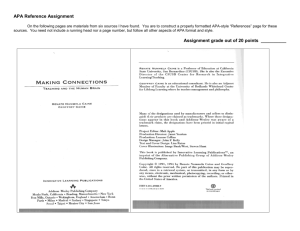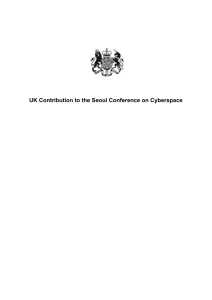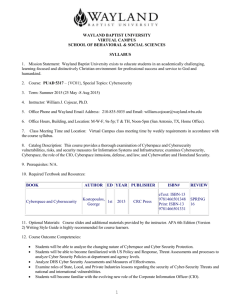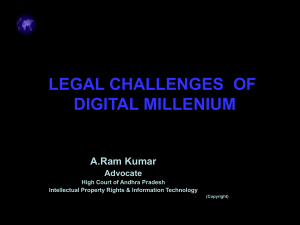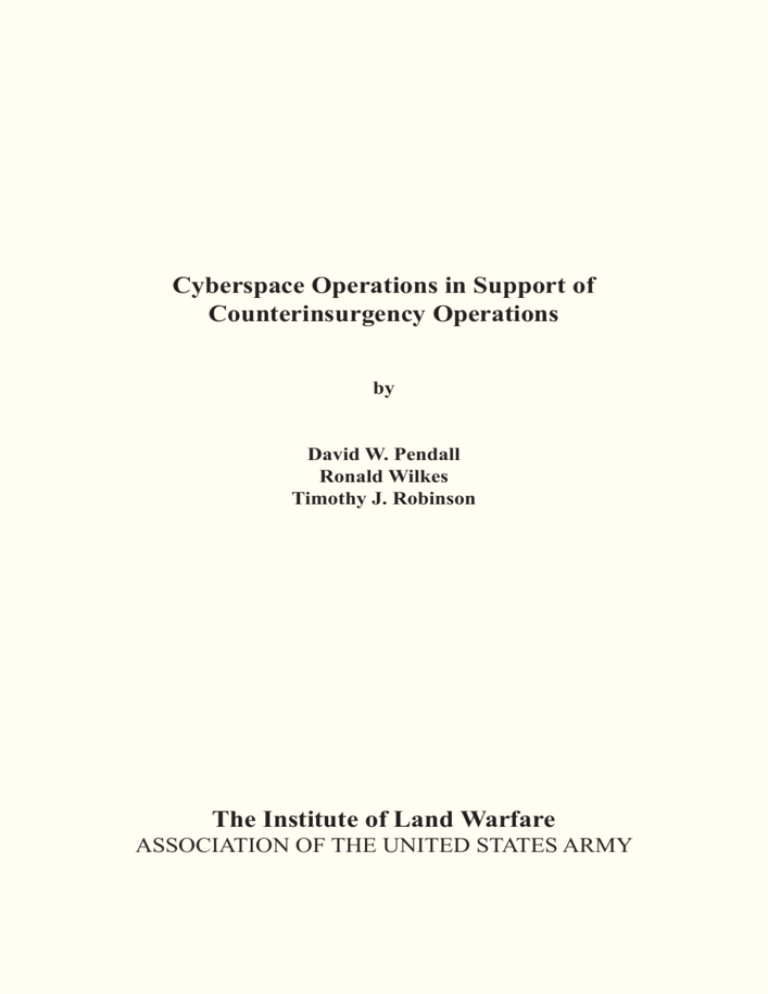
Cyberspace Operations in Support of
Counterinsurgency Operations
by
David W. Pendall
Ronald Wilkes
Timothy J. Robinson
The Institute of Land Warfare
association of the United states army
AN INSTITUTE OF LAND WARFARE PAPER
The purpose of the Institute of Land Warfare is to extend the educational work of AUSA by
sponsoring scholarly publications, to include books, monographs and essays on key defense issues,
as well as workshops and symposia. A work selected for publication as a Land Warfare Paper
represents research by the author which, in the opinion of ILW’s editorial board, will contribute to
a better understanding of a particular defense or national security issue. Publication as an Institute
of Land Warfare Paper does not indicate that the Association of the United States Army agrees with
everything in the paper but does suggest that the Association believes the paper will stimulate the
thinking of AUSA members and others concerned about important defense issues.
LAND WARFARE PAPER NO. 95, April 2013
Cybersecurity Operations in Support of Counterinsurgency Operations
by David W. Pendall, Ronald Wilkes and Timothy J. Robinson
Colonel David W. Pendall is an Army War College Fellow at the Massachusetts Institute of
Technology’s Lincoln Laboratory Security Studies Program. In his previous assignment he was
the Combined Joint Intelligence Officer for Regional Command–East/CJTF-1 in Afghanistan and
concurrently the Intelligence Officer of the 1st Cavalry Division. He has served in key leadership positions within U.S. Army Europe, V Corps, Multinational Corps–Iraq, NATO/International
Security Assistance Force, National Security Agency/Central Security Service and other tacticallevel units. Pendall holds a B.A. from Ohio University, an M.S. from Central Michigan University
and a Master’s in Military Art and Science in Theater Operations from the Army’s School of
Advanced Military Studies.
Lieutenant Colonel Ronald Wilkes, U.S. Army, is currently assigned to U.S. Strategic Command.
He served previously with the Army Cyber Command, 1st Information Operations Command, 18th
Military Police Brigade and the 3d Infantry Division. Wilkes holds a B.S. from Savannah State
College, an M.A. from Webster University and an M.S. from George Mason University.
Major Timothy J. Robinson, U.S. Marine Corps, is a Communication and Information Systems
Officer stationed with Marine Forces Cyberspace Command. He has held numerous positions with
the 9th Communication Battalion and served as an Operations Research Analyst at Marine Corps
Logistics Command. Major Robinson holds a B.S. from Virginia Polytechnic and State University
and an M.S. from the Naval Postgraduate School.
This paper represents the opinions of the author and should not be taken to represent
the views of the Department of the Army, the Department of Defense, the United States
government, the Institute of Land Warfare or the Association of the United States Army or
its members.
© Copyright 2013 by
The Association of the United States Army
All rights reserved.
Inquiries regarding this and future Land Warfare Papers should be directed to: AUSA’s
Institute of Land Warfare, Attn: Director, ILW Programs, 2425 Wilson Boulevard, Arlington
VA 22201, e-mail sdaugherty@ausa.org or telephone (direct dial) 703-907-2627 or (toll
free) 1-800-336-4570, ext. 2627.
ii
Contents
Foreword.................................................................................................................................. v
Introduction.............................................................................................................................. 1
Description of Cyberspace Operations..................................................................................... 1
Establishing Terms of Art and Science..................................................................................... 2
The Need for Agile Cyberspace Operations in the Afghanistan Theater of War...................... 2
Cyberspace Operations in Support of Counterinsurgency and Stability Operations
in Afghanistan.......................................................................................................................... 4
Recommendations for a Way Ahead........................................................................................ 5
Conclusion............................................................................................................................. 10
Endnotes................................................................................................................................. 11
Glossary................................................................................................................................. 13
iii
iv
Foreword
This paper provides a perspective on how best to use cyberspace operations in support of
U.S. military operations in Afghanistan. The authors describe the nature of cyberspace operations in general, discuss the need for enhanced cyberspace operations and express a viable way
ahead for future cyberspace operations in Afghanistan. They posit that additional research and
coordination should be conducted to better define and develop requirements for cyberspace
capabilities, command and control of cyberspace operations and integration of activities in a
manner that supports the International Security Assistance Force commander, the operations of
regional commanders and related strategic shaping and global counter terrorism pursuit operations. The lessons we learn now while fighting the counterinsurgency (COIN) fight will serve
us in future conflicts.
It has become apparent there is more work to be done in exploiting our adversaries’ use
of cyberspace. Insurgents and members of their supporting cells have been captured on the
battlefield with all imaginable types of digital media and Internet-capable devices. Insurgents
and terrorist organizations all have an online presence that is becoming more sophisticated and
useful to their operations. Thus, the authors argue that it is both clear and essential that efforts
to counter our enemies in the Afghan COIN fight must evolve and become more effective. Our
next adversary may be well funded and technologically literate, originate from a more educated
society and may have developed a comprehensive cyber operations doctrine. This paper was
designed to provoke additional thought about cyberspace operational relevance, suggest necessary change and enable future success in Afghanistan and future conflicts.
Gordon R. Sullivan
General, U.S. Army Retired
President, Association of the United States Army
10 April 2013
v
vi
Cyberspace Operations in Support of
Counterinsurgency Operations
Introduction
The United States has fought an innovative, ruthless and persistent enemy in Afghanistan
for more than 11 years. In response to an evolving adversary, the U.S. military developed
counterinsurgency (COIN) doctrine to create a framework for commanders to view their operational environment (OE) and provide new methods of applying all the capabilities at their
disposal. Comprehensive COIN operations are the basis of International Security Assistance
Force (ISAF) campaign planning and tactical operations. While COIN provides a comprehensive strategic framework to use in defeating an insurgency, it lacks any substantive analysis
concerning the value of employing cyberspace operations.
America’s enemies understand the power of technology. The entry cost to using digital
communications is low while the reliability, quality and simplicity of service are generally
high. Open-source intelligence indicates that insurgents use different technologies to communicate, create operational plans, store institutional knowledge and develop strategy. The full
extent of insurgents’ employment of their technological portfolio with respect to command and
control, financing, recruiting, training, propaganda dissemination and knowledge management
remains an unknown. These issues are of particular concern, as they indicate a level of sophistication that can enable and potentially enhance operations against coalition forces. Present
insurgent and/or terrorist cyber-based activities are not fully understood at the operational and
tactical levels. The purpose of this paper is to describe the nature of cyberspace operations in
general, discuss the need for enhanced cyberspace operations in Afghanistan and express a
viable framework for how future cyberspace operations could be more effectively conducted
in Afghanistan.
Description of Cyberspace Operations
Cyberspace operations provide support to traditional military operations and, within some
rare cases and specific opportunities, replace them. Technological solutions, either offensive or
exploitive, assist intelligence and operational planners in targeting individual insurgents or insurgent networks, operating within a larger social network wherein they gain support from the
1
cyber domain. By understanding the digital patterns of life established by insurgents and supporting organizations, U.S. forces can conceptually develop enemy communication models and
better understand their operations and tactical processes. This information improves friendly
situational awareness and adds context to existing knowledge bases.
In some cases, cyberspace operations can replace physical military activities by supporting, enabling, informing and influencing activities. Instead of conducting a direct-action raid
that can unduly risk maneuver forces, a deceptive cyber operation may be more suitable to
shape the target, set favorable conditions for use of kinetic force or disrupt cohesion within
the network. Efforts such as these can cause an adversary to commit a desired action that will
provide a tactical advantage for U.S. forces. Exemplar cyber operations can cause a number
of problems, including but not limited to disrupting target patterns of life, destroying trust
among key actors in enemy networks and delaying or disrupting logistics or financing. Cyber
operations can provide a substantial military effect if resourced, coordinated and executed
properly and synchronized with other kinetic- and non-kinetic-based effects. Furthermore,
these actions may provide military planners with reflections across a network, confirming or
denying existing estimates about threat operational frameworks and insurgent tactics, techniques and procedures.
Establishing Terms of Art and Science
In 2008, senior military leaders within the Joint Chiefs of Staff defined cyberspace operations and its component parts, settling some of the more contentious discussions within the
U.S. cyber community.
Cyberspace operations are defined as “the employment of cyber capabilities where the
primary purpose is to achieve military objectives or effects in or through cyberspace. Such operations include computer network operations and activities to operate and defend the Global
Information Grid.”1 Cyberspace capabilities are comprised of many different elements—such
as computer software, networks and other technologies—that interact with digital or analog
communications. As described in Joint Publication 3-13, Information Operations, cyberspace
operations consist of computer network attack (CNA), computer network exploitation (CNE)
and computer network defense (CND).2
CNA is defined as “actions taken through the use of computer networks to disrupt, deny,
degrade or destroy information resident in computers and computer networks, or the computers and networks themselves.”3 CNE is “enabling operations and intelligence collection
capabilities conducted through the use of computer networks to gather data from target or
adversary automated information systems or networks.”4 Finally, CND is characterized as involving actions taken through the use of computer networks to protect, monitor, analyze, detect
and respond to unauthorized activity within Department of Defense information systems and
computer networks.5
The Need for Agile Cyberspace Operations in the Afghanistan Theater of War
Insurgent organizations and the larger supportive network have several points of presence
on the Internet. Wherever there is access to the Internet, there is the probability it is being
used for strategic communication, information operations (IO), advertisement for recruits, solicitation of funding and ongoing discussions by insurgent organizations. The proliferation of
cellular-based technologies, particularly 3G (the third generation of mobile communication
2
technology), has expanded insurgents’ capability sets. 6 The implication for coalition forces is
that insurgents will progressively gain greater access to cellular devices, some Internet capable,
likely aiding them in command and control of their forces. Insurgents will continue to leverage
these capabilities in opposition to coalition forces, Afghanistan National Security Forces and
the Government of the Islamic Republic of Afghanistan (GIROA).
It would be naïve to think insurgents such as the Taliban, the Haqqani Network or other
negative influences in Afghanistan lack the ability or interest to use information technology
to increase their effectiveness. The threats to a stable Afghanistan are comprised of different
factions with different motivations for fighting or maintaining instability. While they may be
categorized as primitive, cruel, resourceful and committed to opposing the GIROA and coalition
forces, they also possess a superior cultural attunement that the coalition does not. Being poor
and uneducated does not equate to being unresourceful, unintelligent or incapable of developing and adopting combat enablers. The events of the Arab Spring in 2011 indicate the power of
common technologies in countries with some of the world’s lowest Internet penetration levels. 7
While the current Internet penetration level in Afghanistan can also be considered low,
there are indicators that it may not remain so in the near future.8 The following table shows
growth in Afghanistan-based service providers and usage statistics from 2010 to 2011:
Table 1
Telecom Statistics at the end of December 20119
2010
GSM Providers (Licensed)
2011
% Growth
4
4
0
14,855,235
17,558,265
15%
7
7
0
CDMA Subscribers
96,947
134,092
27%
Landlines
63,533
80,607
21%
1,563
1,787
12.5%
3,822
4,428
13.6%
Over 80%
Over 85%
5%
GSM Subscribers
Internet Service Providers
Investments in $ Millions
Telecom Base Stations
Population Coverage
GSM – Global System for Mobile Communication
CDMA – Code Division Multiple Access
There is a clear and growing consumer base for GSM and Internet services. Over the next
three years, Afghanistan’s Ministry of Communications and Information Technology (MCIT)
plans to spend $215.96 million in support of the National E-Afghanistan Program, which “provides an opportunity to bridge the communications gap that exists within the country whilst
also creating new systems of data and information management within a model of new public
management.”10 Since MCIT improvements will benefit Afghanistan as a whole, insurgents
will also be further enabled by these improvements.
Currently, physical and technical conditions contribute to limits on technology accessibility in Afghanistan. To some degree, these limitations hamper insurgents’ exploitation of
this communication medium. Barriers to development range from Afghanistan’s mountainous
geography to poor information technology infrastructure. Lack of technical expertise in the
Afghan workforce may limit the ability of insurgents to recruit suitable technicians to support
3
their operations. As access to technology and the Internet improves, barriers to communication
will decrease significantly and perhaps radically. Metcalf’s Network Law explains that user
networks’ value expands geometrically due to the addition of new nodes.11 Currently, there
are a number of private Afghanistan-based efforts to increase overall access to the Internet
and communications technologies. Projects are in development to emplace fiber-optic cables
to improve connection speeds and reliability. Implementation plans and advertising exist for
3G- and General Packet Radio Service-based networks, which will mark a significant jump in
effective penetration of Internet services.12 Coupled with likely decreases in pricing, the use
of Very Small Aperture Terminals will rise in more remote areas of the country. While there
are difficulties in accessing Internet technology, there remains a strong desire to develop and
use it in daily life, as witnessed by individuals’ attempts to access the information domain via
broadcast radio, television and personal devices connected to the Internet. As the information
environment in Afghanistan becomes more accessible, use by insurgents and their supporting
networks will become routine.
Cyberspace Operations in Support of Counterinsurgency and Stability Operations
in Afghanistan
An insurgency is defined as “an organized movement aimed at the overthrow of a constituted government through the use of subversion and armed conflict.”13 In Afghanistan, the
insurgency is not a monolithic group of Afghan-based fighters. Numerous armed groups are
fighting for different purposes; some are strategic in nature, while others have more materialistic
or self-serving objectives. U.S. and coalition forces are wading through this shifting battlefield by creating innovative and effective solutions to complex problems. Counterinsurgency is
defined as “military, paramilitary, political, economic, psychological and civic actions taken by
a government to defeat insurgency.”14 Integrating cyberspace operations alone will not pacify
or defeat the insurgency in Afghanistan but provides a fast-developing opportunity for creating
significant effects in the overall COIN fight.
While no single element of national or international power will decisively shift momentum, cyberspace operations’ support to COIN will take on increasingly important roles. One
such core role is in complementing intelligence operations to capitalize on the existing use
of the Internet by insurgents. Intelligence support to countering insurgent use of the Internet
begins with defining the OE though the intelligence preparation of the battlespace (IPB).15 IPB
is “the systematic, continuous process of analyzing the threat and environment in a specific
geographic area.”16 To conduct effective cyberspace operations, one must understand the characteristics and composition of the social network and the overall cyberspace environment. A
cyber IPB (CIPB) is critical to provide planners with the information required to understand
and effectively target insurgents in the cyberspace OE. Cyber-based targets have a physical
presence. Planners must understand the physical, logical and persona layers affecting their battlespace in order to conduct operations.
Technology and its uses are dynamic; the constant change requires consistent observation
and evaluation for cyberspace situational understanding and operations. CIPB efforts must be
adjusted to reflect changes to physical and logical structures of the cyberspace environment.
Planners, to the greatest extent possible, must be able to forecast expansion, crossover, migration and additions to the digital topology that may affect U.S. cyberspace operations.
One solution to providing full-spectrum cyberspace operational support to COIN is to
have a centralized and integrated planning and execution capability in theater to support the
4
commander in achieving theater-based objectives. Integrated theater cyber operations increase
the risk to the insurgents using cyberspace and illuminate their supporting actors. Denying their
anonymity, taking away their “free pass” and creating active operational effects is an important
component in this fight. U.S. Cyber Command (USCYBERCOM) support must be deployed
in a responsive, compact organization, be granted the authority to decide and act as required
by the operational commander they support and be equipped with decentralized, preapproved
action capability at the theater and regional command levels. There cannot be a complicated
system controlling all effects produced by cyberspace capabilities; rather, cyber operations and
effects need to be timely, streamlined and assured by responsive teams. U.S. forces must have
the ability to decide quickly on the time and place for use of cyber capabilities to disrupt, deny,
degrade or destroy an enemy’s capacity to generate combat power in the physical or digital
realm. A cyber-based “fires net” concept will lead to this capability.17
General Gary Luck, U.S. Army Retired, and Colonel Mike Findlay, U.S. Army Retired, developed a concept to demonstrate this framework.18 Leaders’ main concerns about any approval
process often center on the amount of time it takes for a decision to be made. Tactical advantages in exploiting emerging opportunities are inherently linked to time; the longer it takes to
make a decision, the more quickly the advantage is lost. Decentralizing the approval level and
collaborating horizontally in a shorter time span (faster action cycles) will support commanders in achieving a tactical advantage. Figure 1 on the following page depicts the relationships
between decision and action.
In particular, USCYBERCOM must be able to conduct CNA and CNE against targets on
the Joint Effects List to disrupt insurgent network operations both in Afghanistan and globally. 20
Cyberspace operations should take a global offensive posture to reduce the effectiveness of insurgent finances, propaganda and command and control efforts. Additionally, USCYBERCOM
should target individuals deemed to be negative influences, directly and indirectly, in order
to support ISAF and United States Forces–Afghanistan non-kinetic operations. Creation of
capacity to support cyberspace operations requires the design and establishment of a robust
cyber support element, creation of an independent expeditionary cyberspace element located
in Afghanistan and, finally, assigning to each U.S.-led regional command (RC) an increased
digital network intelligence capability.
Recommendations for a Way Ahead
The agenda for implementing any significant change in current operations must start with a
suitable framework that includes adherence to the laws affecting cyberspace operations, agency
practices and theater organizational structures. None of these changes or amendments is simple
or without risk. However, a total reexamination of how USCYBERCOM and the National
Security Agency (NSA) conduct operations is required to ensure unity of effort and to manage
efficiently the short supply of personnel and materials.
Cyberspace operations must be responsibly executed within legal titles and authorities
contained in U.S. law; however, there seems to be an imbalance of evolution. The pace and
direction of technological developments quicken each day, yet the laws that regulate these
activities do not. The law must keep pace with technological developments to allow those
planning and executing cyberspace operations the flexibility and agility required to accomplish their mission—to support warfighting commanders with integrated, synchronized cyber
effects.
5
Figure 1
Decentralized Authority19
Mission Approval Levels
President/SecDef
Centralized
(High approval level)
GCC
JTF
APPROVAL
PROCESS
Standard Process
Unit
Decentralized
(Low approval level)
Time
President/SecDef
Centralized
(High approval level)
GCC
JTF
Alternate Method 1
APPROVAL
PROCESS
“A priori” decisions, trust and
confidence, and supported/ing
command relationships solutions
Unit
Decentralized
(Low approval level)
Time
President/
SecDef
Centralized
(High approval level)
GCC
Alternate Method 2
APPROVAL
JTF
PROCESS
Technological and organizational
solutions
Unit
Decentralized
(Low approval level)
Time
Insights
• Delegate to the point of being “uncomfortably decentralized”
• Gain agility through horizontal collaboration
• Take advantage of emerging opportunities within chaos of battle
SecDef − Secretary of Defense
GCC − Ground Component Commander
JTF − Joint Task Force
6
U.S. Code Titles 10 and 50 define the roles and responsibilities of the armed forces and
the intelligence community (IC), respectively.21 Close cooperation and coordination would be
required among USCYBERCOM, NSA and the greater IC to leverage their unique capabilities and authorities within defined legal restraints. While other members of the IC have a role
in cyberspace operations, USCYBERCOM and NSA retain the dominant amount of personnel, capabilities and authorities. The relationship between these two organizations will largely
dictate how cyberspace operations are conducted. Differences in titles and authorities between
organizations are not an insurmountable obstacle. The obstacle will be changing the cultures
and operational interaction between organizations in a way that allows them to collaborate
within the framework of their legal authorities.
USCYBERCOM should consider creating a continental United States (CONUS)-based
support cell called the USCYBERCOM CONUS Support Element, dedicated to providing continuous intelligence, technical and legal support to deployed CNO elements. This organization
must be staffed with military and civilian intelligence officers capable of providing a wide
range of timely support—including intelligence, research, legal review and interagency coordination—to deployed personnel. The authority to act autonomously within defined operational
parameters is critical to allow the full range of cyberspace support.
As depicted in figure 2, forward-deployed elements must receive unified, agile and timely
support from all cyber operations stakeholders.
Expeditionary Cyber Operations. In any conflict, intelligence enables operations. This concept
also holds true for cyberspace operations. The USCYBERCOM CONUS Support Element
must collect, process and analyze data for rapid delivery to expeditionary cyberspace support
elements. This type of support requires intelligence analysts to perform both technical and traditional analysis continuously because there is no “off switch” for the Internet. Time zones do not
apply and many interactions are asynchronous. Analysts must pay significant attention to their
collection strategy and the sensitive operations they support.
To make the operational and RC-level cyber support elements more effective, they must
develop greater capabilities and operational reach. Therefore, USCYBERCOM should develop
a Theater Cyber Support Element–Afghanistan concept. This enhanced organization would have
expanded authorities and capabilities to be leveraged at the direction of theater leadership under
coordinated Title 10 and Title 50 authorities. The following serves as a potential model for future
cyber COIN operations, theater/combatant command and joint task force/regional commands.
The Theater Cyber Support Element–Afghanistan would be leveraged to increase cyberspace operations supporting operational objectives outlined by the Commander ISAF and
executed by RC teams. This commander must have the ability to effectively direct cyberspace
operations in his battlespace. Additionally, he must be able to conduct cyberspace operations
outside of his physical battlespace if cyber-based entities have a negative impact on his OE or
ability to achieve his operational objectives. The cyber component of his enemy has no physical
boundaries or territory.
USCYBERCOM’s goal should be to enhance kinetic and non-kinetic operations in support
of military information support operations, information operations, targeting and conventional
intelligence operations.
The primary mission of the Theater Cyber Support Element–Afghanistan would encompass three distinct areas. First, this organization needs the ability to proactively and reactively
7
Figure 2
Proposed Organizational Relationship Between
U.S. Cyber Command and the International Security Assistance Force
U.S. Cyber Command CONUS Support Element
A
B
NSA/
Intelligence
Community
U.S. Cyber
Command
A U.S. Cyber Command
C
Service
Component
(Title 10)
•
•
•
•
•
Staff Sections (J-2/3/7/OPT)
Funding
Doctrine
Research and Development
Authorities
B National Security Agency/
Intelligence Community
• Collection
• Research and Technology
• Others as required
C Service Component (Title 10)
Combined team supporting
expeditionary cyberspace operations
• Personnel
• Funding
• Training
D
D Supports Theater Cyber Support Element
• CNE used to develop meaningful intelligence
supporting counterinsurgency operations
• CNA directed by command in theater of war
• CND support via IAD
E
Theater Cyber
Support Element −
IJC/ISAF (Kabul)
F
Regional Cyber
Support Element −
Southwest (USMC)
Full-Spectrum
Cybersecurity Operations
in Support of
Counterinsurgency
Operations
E Theater Cyber Support Element −
IJC/ISAF (Kabul)
• Directs CO in support of combatant commander
• Provided with authorities and capabilities
• Allocates resources
• Supports ISAF/U.S. Forces Afghanistan
G
Regional Cyber
Support Element −
East (USA)
F Regional Cyber Support Element −
Southwest (USMC)
• Conducts research
• Identifies division targets
• Develops division targets
• Requests fires
• Supports division priorities
H
G Regional Cyber Support Element − East (USA)
Regional Cyber
Support Element −
South (USA)
•
•
•
•
•
Conducts research
Identifies division targets
Develops division targets
Requests fires
Supports division priorities
H Regional Cyber Support Element − South (USA)
CNA − Computer Network Attack
CND − Computer Network Defense
CNE − Computer Network Exploitation
CO − Cyber Operations
CONUS − Continental United States
IAD − Information Assurance Directorate
IJC − International Joint Command
ISAF − International Security Assistance Force
NSA − National Security Agency
OPT − Operational Planning Team
USA − United States Army
USMC − United States Marine Corps
8
•
•
•
•
•
Conducts research
Identifies division targets
Develops division targets
Requests fires
Supports division priorities
Figure 3
Relationship Between the Logical and Physical Environments22
People
Cyber Identity
Information Layer
Physical Infrastructure
Geographic Layer
counter insurgent propaganda. This could be support to IO or offensive cyber operations.
Second, cyberspace operations could include the pursuit of insurgents and/or hierarchical
structure in both cyber and physical domains. CNO should be fully integrated with the targeting process to develop a more complete picture of insurgents’ networks (personalities,
finances, relationships, etc.). While some of this integration does occur on a limited basis, it
generally happens only at the national level and is insufficient to serve operational and tactical
commanders across the scope of their mission. Finally, the USCYBERCOM Theater Cyber
Support Element–Afghanistan should establish cooperation with NSA’s Information Assurance
Directorate to U.S. military communications providers. This relationship would provide RCs
with access to an additional pool of CND expertise.
This enhancement to cyberspace operations could be achieved through relevant, measurable, responsive and properly resourced actions. The structure of the Theater Cyber Support
Element–Afghanistan would require specially trained individuals to perform a range of duties.
Among the most important personnel requirements is assignment of digital network intelligence
analysts and CNO planners. Theater-level cyberspace operations would require a significant
amount of coordination with RCs. RC cyberspace planning cells would become the conduit for
information flow from the tactical level to the operational level.
RC cyberspace planning cells should be focused at the tactical level, targeting insurgents
and their networks. These cells must plan cyberspace operations supporting tactical objectives
outlined by regional commands. The senior military commander in an RC must be able to
request cyberspace operations in his battlespace to shape kinetic, non-kinetic or intelligence
operations in a timely fashion. As cyber operations are simply another tool, the commander
must be able to synchronize tactical and operational cyber effects with the other tools and
9
operations he directs. To make major gains, cyber operations must be postured for speed and
clearly demonstrate relevance to the regional commander.
RC cyberspace planning cells should consist of a basic CNO planning team capable of
conducting independent research to develop and nominate targets. At a minimum, RC-focused
cyber support should include Digital Network Intelligence and Dialed Number Recognition
analysts, an all-source intelligence analyst and access to all required network connections and
tools used to conduct digital network analysis. With this level of staffing and resources, the
RC cyber support teams would be capable of conducting full-spectrum target analysis and
transmitting that information to the theater cyber support element for action. All prioritization
and deconfliction would take place in theater to rapidly execute operations in support of ISAF
command priorities and RC operational and tactical requirements.
An Existing Model for Consideration. The signals intelligence (SIGINT) community support
to combat operations presents a viable model for USCYBERCOM to provide commanders
with a responsive and deployable operational cyberspace capability. Through this organization,
the IC provides expeditionary cryptologic intelligence support from the combatant commander
down to the division and brigade combat team levels in Afghanistan. This is accomplished
through a tiered support structure that delegates authorities and responsibilities to SIGINT
organizations within theater for specific mission areas. This concept of support provides commanders with responsive and focused intelligence capabilities in a manner applicable to future
operational cyberspace support.
Expeditionary cyberspace operations and SIGINT have similar operational goals and analytical tools. Both strive to provide support down to the lowest level of combat operations and
leverage national intelligence capabilities in a manner consistent with U.S. law to achieve
forward deployed forces’ operational objectives. The SIGINT model of support is mature and
well tested and has the confidence of military commanders; it is a template for cyberspace
forces to build future policies and procedures and to determine personnel composition based
on a structurally sound frame.
Conclusion
It is of vital importance that the U.S. cyber and warfighting communities be fully aware of
the increasing role that cyberspace operations can play in Afghanistan. This paper advocates an
expanded approach in providing authority and structure to the senior and regional commands
in Afghanistan, as well as integrating a more robust Cyber IPB effort on the part of the broader
headquarters’ planning and operational efforts. This paper offers a usable template for the future
organizational structures required to enhance current efforts. The challenges presented are not
difficult to overcome, but the will to change the status quo and embrace a different perspective
is necessary. The agencies and commands involved in supporting combat operations have different cultures and methods of conducting operations. Some organizations are responsible for
conducting intelligence operations while others are responsible for creating effects that support
strategic objectives. The common bond between them is that the sum of their actions provides
a tangible effect on the mission and supports the warfighter.
10
Endnotes
1
General James E. Cartwright, Vice Chairman, Joint Chiefs of Staff, “Definition of Cyberspace
Operations,” action memorandum for Deputy Secretary of Defense, Washington, DC,
29 September 2008.
2
Department of Defense, Joint Publication (JP) 3-13, Information Operations (Washington, DC:
Department of Defense, 13 February 2006), http://www.carlisle.army.mil/DIME/documents/
jp3_13.pdf.
3
Ibid., p. GL-5
4
Ibid., p. GL-6
5
Ibid., p. GL-5
6
Ian Simpson, “Afghanistan sees move to 3G in 2011,” Reuters Online, 23 November 2010, https://
uk.reuters.com/article/2010/11/23/oukin-uk-afghanistan-telecoms-idUKTRE6AM3PT20101123;
Afghanistan Government Minister Baryalai Hassam (Deputy Minister Technical) stated that the
Afghan Telecom Ministry is in negotiations with Afghan telecommunications companies to upgrade
services to 3G and is intent on eventually upgrading to 4G services.
7
Ekaterina Stepanova, “The Role of Information Communication Technologies in the Arab Spring:
Implications Beyond the Region,” Policy Memo No. 159 (Washington, DC: The Program on New
Approaches to Research and Security in Eurasia, May 2011); during the uprisings throughout the
Middle East (particularly Tunisia and Egypt), also known as the “Arab Spring,” information technology played a substantial role in contributing to the coordination efforts of protestors. Websites such
as Facebook and Twitter, various blogs and the use of text messages were all enablers for communications between various members of protest groups.
8
As shown in June 2012 research conducted by the International Telecommunication Union, “Internet
Users by Country,” and Internet World Stats: Usage and Population Statistics, “Internet Users in
Asia”; as of 30 June 2011, it is estimated that approximately 3.5 percent of Afghanistan’s population
have access to the Internet. This assessment is defined by fixed or wired broadband Internet subscriptions. The world average is 28.8 percent. See http://www.internetworldstats.com.stats3.htm
and http://www.gfmag.com/tools/global-database/ne-data/10287-internet-users-by-country.html.
9
Afghanistan Ministry of Communication & Information Technology, 9 February 2012,
http://mcit.gov.af/en/page/12.
10
See “Afghanistan National Development Strategy: Prioritization and Implementation Plan,” Kabul
International Conference on Afghanistan, 20 July 2012, p. 85, http://www.afghaneic.org/library/
other/ANDS/ANDS-%20Prioritization%20and%20Imaplementation%20Plan%20Volume%20II.pdf.
11
Scott Kirsner, “The Legend of Bob Metcalfe,” Wired, vol. 6, no. 11, November 1988, http://www.
wired.com/wired/archive/6.11/metcalfe_pr.html; Dr. Robert Metcalfe’s Network Law: “The value
of a network grows as the square of the number of its users. Or, more plainly stated: The more users
who can talk to each other on a network, the more valuable it is.”
12
Margaret Rouse, “SearchMobileComputing: GPRS (General Packet Radio Services),” last modified May 2007, http://searchmobilecomputing.techtarget.com/definition/GPRS; both 3G and GPRS
provide a faster data rate to users than GSM, which is the primary communications protocol used in
cellular communications in Afghanistan.
13
Department of Defense, JP 1-02, Department of Defense Dictionary of Military and Associated
Terms (Washington, DC: Department of the Army, 20 March 2006).
11
14
Ibid.
15
Department of the Army, Field Manual (FM) 1-02, Operational Terms and Graphics,
21 September 2004, p. 1-102.
16
Department of the Army, FM 3-24/Marine Corps Warfighting Publication 3-33.5,
Counterinsurgency, 15 December 2006.
17
Department of the Army, U.S. Army Training and Doctrine Command (TRADOC) Pamphlet
525-3-4, The U.S. Army Functional Concept for Fires 2016–2028, 13 October 2010, p. 35; a fires net
“provides assured communications, capacity and timeliness to expedite the clearance and execution
of offensive and defensive fires.”
18
General Gary Luck (USA Ret.) and Colonel Mike Finley (USA Ret.), “Joint Operations, Insights and
Best Practices,” 2nd ed. (Norfolk, VA: Joint Warfighting Center, July 2008), http://www.au.af.mil/au/
awc/awcgate/jfcom/joint_ops_insights_july_2008.pdf.
19
Ibid., p. 47.
20
Joint Effects List (JEL) is not a doctrinal term contained in official Army doctrine (FM 1-02,
Operational Terms and Graphics, September 2004). However, it is widely accepted as a valid doctrinal term and concept used for targeting within forward deployed military organizations.
21
House of Representatives, Committee on Armed Services, Title 10, United States Code Armed
Forces (Washington, DC: U.S. Government Printing Office, July 2011), http://armedservices.house.
gov/index.cfm/files/serve?File_id=fc0173d5-f7d3-4d74-8d42-1b9e185b7c6b; Title 50, War and
National Defense, http://uscode.house.gov/pdf/2011/2011usc50.pdf.
22
Department of the Army, TRADOC Pamphlet 535-7-8, Cyberspace Operations Concept Capability
Plan 2016–2028, 22 February 2010, p. 8.
12
Glossary
CDMACode Division Multiple Access
CIPBCyber Intelligence Preparation of the Battlespace
CNAComputer Network Attack
CNEComputer Network Exploitation
CNDComputer Network Defense
COCyber Operations
COINCounterinsurgency
CONUSContinental United States
FMField Manual
GCC Ground Component Commander
GIROA Government of the Islamic Republic of Afghanistan
GPRS General Packet Radio Service
GSM Global System for Mobile Communication
IADInformation Assurance Directorate
ICIntelligence Community
IJCInternational Joint Command
IOInformation Operations
IPBIntelligence Preparation of the Battlespace
ISAFInternational Security Assistance Force
JEL Joint Effects List
JP Joint Publication
JTF Joint Task Force
MCITMinistry of Communications and Information Technology
NSANational Security Agency
OEOperational Environment
OPTOperational Planning Team
RCRegional Command
SecDefSecretary of Defense
SIGINTSignals Intelligence
TRADOC U.S. Army Training and Doctrine Command
USA United States Army
USCYBERCOM United States Cyber Command
USMC United States Marine Corps
13

